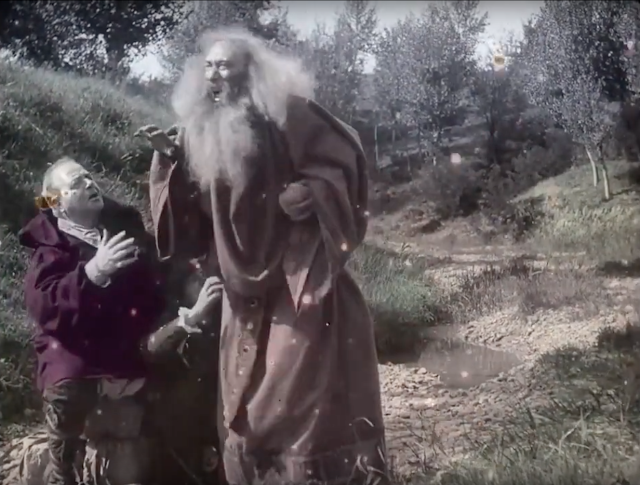"Look here, upon this picture..."
"... and on this." Different Play, Act III Scene 4
After the surprising delights of Peter Brook's seventy-three-minute-long 1953 King Lear yesterday, I decided to revisit Gerolamo Lo Savio's extravagantly-hatted, fourteen-minute-long silent 1910 version from the BFI collection Silent Shakespeare, posted at the top.
 In looking that up I discovered an even earlier, thirteen-minute-long, German-subtitled version from 1909 credited to the Vitagraph Company of America, so I thought I'd post that too.
In looking that up I discovered an even earlier, thirteen-minute-long, German-subtitled version from 1909 credited to the Vitagraph Company of America, so I thought I'd post that too. Comparisons are invidious, but what else are we going to do?
The most surprising thing both versions share is an absolutely stand-out Oswald. Goneril's servant, it's a small but satisfying role, whose job both literally and narratively is to just turn up and be a dick. Above is the Vitagraph version, fully understanding the assignment as he bounds out and tells everyone to eff off. Below is Lo Savio's. I remembered the 1910 version having excellent facial hair and helmets, and I was right. Just look at him there on the left. This Oswald may not have received the promotion to chief antagonist Brook gave him in 1953,
despite this 1910 version also cutting the subplot, but he definitely gets the outfit hardest to ignore, against stiff competition too.
That's Kent in the middle, gobsmacked by his cheek. Required by the plot to disguise himself as a servant by simply shaving, Kent looks very underdressed in this company. The shorter 1909 version not only keeps the suplot, involving Edmund and Edgar – YAY! – but also devotes a whole scene to Kent shaving. He gets to keep the moustache too. In the following scene, having picked another fight with Oswald, Kent is sentenced to the stocks. That's Oswald behind him leaping for joy. What a dick.
Compare this scene to the 1910 version. Again, excellent helmets. But...
In general, as gorgeous as this later, hand-tinted version looks, it does come across as a bit of a shambles compared to Vitagraph's effort: Like many blockbusters, a lot more time and care seems to have been spent on it in post than during the actual shoot. Here's the 1910 version's storm scene...
... minus the storm, because we're filming outside on a clear day because it's 1910. Feigning madness without a script is also quite a big ask, especially when you're missing the rain and thunder that's meant to push you over the edge, so after quite a lot of faff with a cloak, Ermete Novelli's Lear tries to fix this narative lapse by punching a rock and going Ow.
Again though, it was 1910. Cut the film some slack.
Let's compare this to Vitagraph's earlier 1909 version...
Oh okay! Sure! If you want to go the traditional route, I suppose you could always bring out a backdrop, run a shower in front of the camera and scratch lighning flashes directly onto the film, but...
Okay no, this is clearly much better. But aren't you just rushing everything if you have to include the subplot? Only providing a series of tableaux vivants? What about later, when Lear is discovered lost to his madness but drifiting in and out of a state of revelation? (Sorry, SPOILERS... that's a joke of sorts, but actually if you don't know King Lear, there will be spoilers coming.) Here's the Vitagraph:
Having kept the subplot, this Lear also keeps its full complement of witnesses: Lear flanked by the banished and debased Edgar, and Gloucester, the father who banished and debased him, blinded now by allies of the son he promoted. Here's the 1910 version:
Having lost both the subplot and the blinding of Gloucester, and of course the storm – but having definitely hurt his hand, let's not forget that – Ermete Novelli now improvises some "Whose Line Is It Anyway?" business with a broomstick, abandoning the narrative pretty much entirely before shuffling off stage right with a cry of whatever the Italian is for "Wheee I'm a witch, byeeee!"
When he later comes to on a cheetah skin we're back in the play, but the hand-tinters seem to have called it a day...
For both 1909 and 1910 Lears, the reconciliation scene with his banished daughter Cordelia is played as eccentrically as the madness scenes, meaning Vitagraph's William V. Ranous gets to keep his dignity, while Novelli, for whom that ship had long sailed, still gets to go noodly noodly, but in a happier vein than before. The Vitagraph version also provides a harpist for Ranous. I don't know if that made any difference to the accompaniment. Nice helmet bottom right too.
Here, of course, is where the story should end, and where, even with their tiny truncated running times, both versions show the strength of the play's final act. Vitagraph also manages to cram in a final fight between Edmund and Edgar, before somehow managing to rig a slowly setting sun over the final image of Lear grieving for his hanged daughter through disintegrating filmstock.
And I even stopped laughing at Novelli (put that on your poster!) There is nothing comic in him bringing on Cordelia's body, and while the 1910 version doesn't give us a sunset, it does manage an impressive number of distant extras to the left of the frame and a possibly fake bridge.
Unfortunately 1910 Lear's grief turns loopy almost immediately, and the film cuts just as it looks like he was about to get better.
Still, I'm very glad there was a record of whatever it was Ermete Novelli thought he was up to.
And the hats are great.
Also, good to see Oswald survived.
















Gosh, Novelli might have the first recorded Dreamworks Face in history! https://tvtropes.org/pmwiki/pmwiki.php/Main/DreamworksFace
ReplyDeleteGod, that made me laugh! Fab fun!
ReplyDeleteThanks. It was fun to do!
Delete